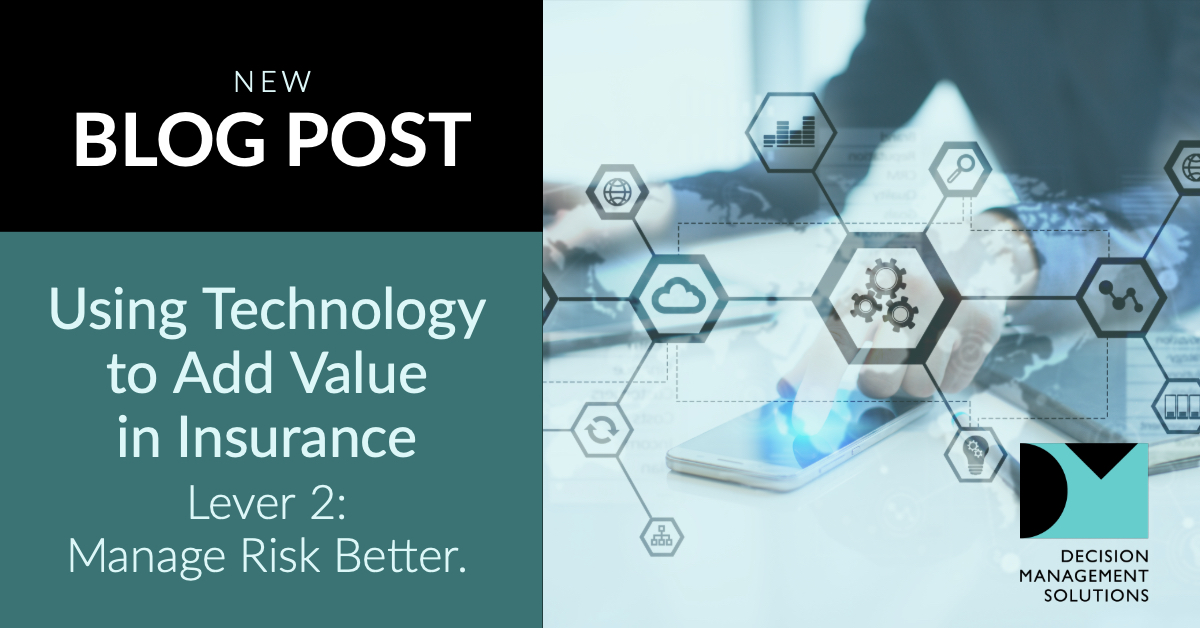In February, we published a blog post on “Using Technology to Add Value in Insurance”. In that post, I referenced Matt Josefowticz’s article – Technology May be the Answer for Insurers, but What Was the Question?, in which he states there are only three levers of value in insurance: Sell More, Manage Risk Better (aka underwriting and adjusting), and Cost Less to Operate.
Let’s dive into greater detail on the second lever – Manage Risk Better. One of the most significant ways in which carriers manage risk is through the underwriting, adjustment and pricing process. Predictive analytics can make a significant impact in this process, helping to ensure that carriers accept and price policies to properly balance the medical or financial risk against the value of the premiums.
The use of predictive analytics in the underwriting decision increases the efficiency and consistency of risk evaluation. Predictive analytics streamlines the decision to maximize efficiency and accuracy, enabling carriers to be smarter about risk while automating more decisions. In addition to automation benefits, predictive analytics also provide the opportunity to glean new insights from customer data.
Predictive analytic models can also address complex interrelationships between data elements that contribute to risk and may be too subtle to be recognized by an underwriter. Applications with these scenarios can then be flagged and referred to underwriters for additional review. The use of predictive analytics enables underwriters to focus on those areas of an application where evaluation by an individual can make a difference in the outcome.
Insurers can also manage risk more effectively through continuous improvement. Business rules, policies, and predictive analytic models can be challenged in a controlled environment to pursue better risk management approaches. Typically, this involves simulating changes to rules or policies prior to making those changes live, then making the change and measuring the effectiveness of the change over time. With this process, a carrier can continually review and update their approach in a smart, controlled way.
The foundation of many continuous improvement philosophies is a champion/challenger approach. This means comparing two or more strategies in order to promote the one that performs the best. These are not one-off attempts to improve results but an ongoing part of a continuous improvement culture. Carriers can make significant improvements in decision-making over time in a controlled manner. Planning for continuous improvement also allows for a low-risk initial implementation, reducing the time to get a new approach into production.
Finally, better managing risk relies on business ownership and collaboration. Creating a culture of risk management and continuous improvement is essential for carriers to thrive. According to McKinsey and Company, in the paper, Building a Culture of Continuous Improvement in Insurance, to be successful carriers ”need to protect their current competitive advantages, while rethinking business models and launching new ideas.”
To do so, successful carriers needed to redefine the role of the business leader. It’s no longer sufficient to make a speech at an initiative kick-off off ceremony and delegate the day-to-day work to the selected team managers. The business leaders responsible for risk management across the organization need to be invested in the outcome and collaborating across the enterprise to share best practices, ideas and the results of champion/challenger tests.
Better managing risk is an essential lever in a successful insurance carrier. While there are many people and processes that contribute to managing risk, from a Decision Management perspective, we believe predictive analytics, continuous improvement, and business ownership are three that can make an immediate positive impact. Contact us to learn more about how Decision Management Solutions can help your organization improve your decision-making approach and better manage risk.
